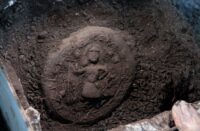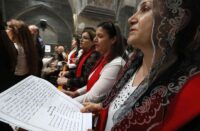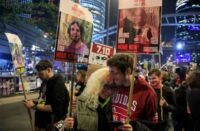
Originally published in CBN News
Gazans cheered in the streets as the ceasefire came into effect. Senior Hamas official Khalil al-Hayya on Friday called it “a victory” to his movement. But like the three previous wars between Israel and Hamas, this one ended tentatively. Israel said it crippled Hamas’ terror infrastructure while Hamas claims it still has the military resources to target Israeli civilians with more rockets.
Earlier, Israeli Prime Minister Benjamin Netanyahu’s office released a statement saying, “The Political Security Cabinet unanimously accepted the recommendation of all security officials, the chief of staff, the head of the Shin Bet, the head of the Mossad and the head of the National Security Council, to accept the Egyptian initiative for a bilateral ceasefire without any conditions, which will take effect later.”
The statement boasted of “significant achievements in the operation, some of which are unprecedented.”
It also included a veiled threat against Gaza terrorists. “The political leaders emphasized that the reality on the ground will determine the future of the campaign,” the statement said. Hamas also threatened to target Israeli civilians if Israel doesn’t keep the truce.
More than 4 000 rockets fired
Fighting first broke out on May 10. Hamas and other terrorists in Gaza fired almost non-stop barrages of more than 4 000 rockets at Israeli cities filled with civilian targets. The rockets brought life in Israel’s southern communities to a standstill, and Israel said it retaliated by pounding Hamas’ underground terror tunnels network, rocket launchers, and other military targets.
At least 230 Palestinians were killed, including 65 children, according to the Gaza Health Ministry. Twelve people in Israel, including a five-year-old boy and 16-year-old girl, were killed.
Israel contends that the majority of the dead are Hamas operatives while dozens were unintended civilian deaths. Israel says Hamas uses its population as human shields by embedding itself in residential areas.
Israel’s Iron Dome defense shield knocked down a majority of the deadly terrorist missiles before they could take Israeli lives, otherwise, the death toll would have been much higher on the Israeli side.
Palestinian terrorist groups have tied the fighting to events in Jerusalem, both to unrest at Al-Aqsa Mosque on the Temple Mount during the Muslim holy month of Ramadan, and the threatened eviction of Palestinian families from the Sheikh Jarrah neighborhood in eastern Jerusalem. After declaring itself the defender of Jerusalem, Hamas launched rockets across southern and central Israel, including a rare rocket attack on the holy city.
“All of us are sacrifice for Palestine, all of us are sacrifice for Jerusalem al-Aqsa,” al-Hayya said after the ceasefire.
Hamas foreign relations official Osama Hamdan said the terror group had received assurances regarding Israeli policy in Sheikh Jarrah and the Temple Mount. Defense Minister Benny Gantz denied Hamdan’s claim and called it “completely false.”
International community praise the ceasefire
Shortly after the ceasefire agreement was announced, US President Joe Biden issued a statement welcoming the end to hostilities.
“I believe the Palestinians and Israelis equally deserve to live safely and securely and enjoy equal measures of freedom, prosperity and democracy,” Biden said. “My administration will continue our quiet, relentless diplomacy toward that.”
Biden also said America would help Israel restock its Iron Dome interceptors.
The head of the United Nations welcomed news of the ceasefire and urged Israelis and Palestinians to negotiate for long-term peace.
“Israeli and Palestinian leaders have a responsibility beyond the restoration of calm to start a serious dialogue to address the root causes of the conflict,” Secretary-General Antonio Guterres told reporters.
A political lifeline for Netanyahu?
The fighting could have offered Netanyahu a political lifeline.
“Netanyahu has always thrived in environments of uncertainty, of chaos and crisis,” Mitchell Barak, an Israeli pollster, director of Keevoon Global Research, and former aide to Netanyahu told the Wall Street Journal. “He basically goes from crisis to crisis.”
Just days before the fighting began, Netanyahu’s political opponents were poised to form a new government and potentially unseat him as Israel’s longest-serving prime minister.
But as the fighting in Gaza raged on and violence broke out between Jews and Arabs in Israel’s streets, Naftali Bennett, leader of the right-wing Yamina party, pulled out of talks to form a rival government with Arab partners last week. Bennett’s decision was a major blow to Netanyahu’s political rivals, but even if he joined Netanyahu’s camp, Netanyahu still doesn’t have the 61-seat majority he needs to form a right-wing government and guarantee his political future as Israel’s prime minister.
Centrist Yair Lapid is leading the bloc of parties attempting to unseat Netanyahu. He has until June 2 to form a new government. If Lapid fails, it will be up to the Knesset, Israel’s parliament, to form a government. The Knesset would have three weeks to choose a prime ministerial candidate. If that also fails, Israel will head to its fifth election in two years.
The Jerusalem Post reported Thursday that Lapid has made some progress behind the scenes toward building a government that could replace Netanyahu. He is reportedly in talks with Bennett despite his earlier decision to pull out of negotiations with the anti-Netanyahu bloc.
After the ceasefire was announced, Lapid praised the military but said Israel needs a new government to combat Hamas.
“If we want to prevent the next time around, Israel requires a different government that will be able to draft the international community to rehabilitate Gaza, but use the building process to remove Hamas’s weapons,” he wrote on social media.
Amid all this, Netanyahu is on trial for corruption. He denies any wrongdoing.







